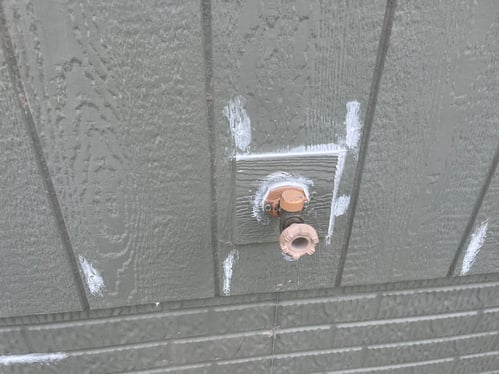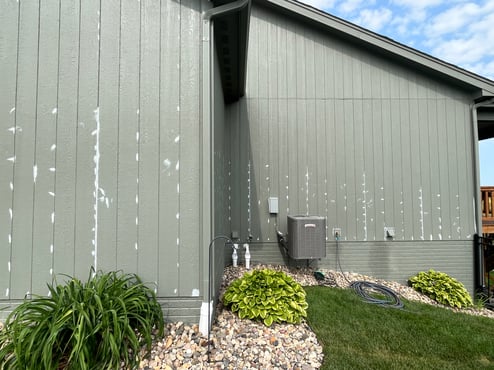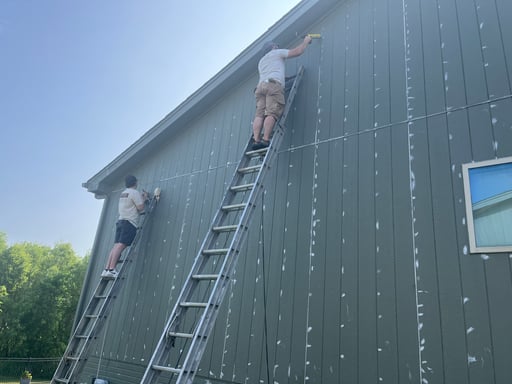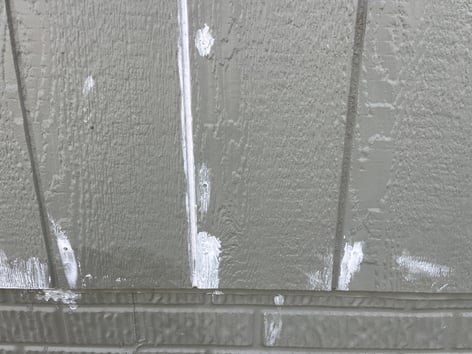Search for topics or resources
Enter your search below and hit enter or click the search icon.
April 10th, 2024
3 min read

Exterior painting is a transformative and crucial aspect of maintaining and enhancing the appearance of your home. However, before you call your painter or pull out your paintbrush, there's a critical step that often goes overlooked, that you should be sure gets done; caulking.
Applying caulk may seem like a minor detail, but it plays a significant role in ensuring the longevity and durability of your exterior paint job.
At Brush & Roll Painting in Omaha, NE, we have painted thousands of homes' exterior to stand out in neighborhoods since 1996. Our thorough prep work process and use of high-quality products have proven to be long-lasting.
In this article, we'll emphasize why caulking before exterior painting is essential, focusing on the significance of using high-quality caulk. By reading this article, you will understand the benefits of caulking before exterior painting, which will help you find the best painter to get your job done.
 One of the primary purposes of caulk in exterior painting is to create a watertight seal.
One of the primary purposes of caulk in exterior painting is to create a watertight seal.
High-quality caulk is designed to seal gaps and cracks effectively, preventing water from infiltrating your home's exterior. Water intrusion can lead to many problems, including rot, mold, mildew, and damage to your home's structural integrity.
By sealing gaps around windows, doors, and other vulnerable areas, you can safeguard your home against water-related issues that can be costly to repair in the long run.
Caulking isn't just about keeping water out; it's also about keeping your home comfortable and energy-efficient.
When gaps and cracks are sealed properly, it helps maintain a consistent indoor temperature. This means that during hot summers and chilly winters, your HVAC system won't have to work as hard to keep your home comfortable.

Besides water and energy concerns, caulk is a barrier against unwanted pests. Insects and rodents can easily find their way into your home through tiny openings.
High-quality caulk can seal these gaps, preventing pests from invading your living spaces. This not only protects your home but also ensures a healthier living environment for you and your family.
Exterior painting is not just about protection; it's also about aesthetics.
A well-caulked surface provides a smoother and more polished finish for your paint job. It hides imperfections, creates clean lines, and ensures the paint adheres properly.
Without proper caulking, your paint job may look uneven, unsightly, and less professional.
 The longevity of your exterior paint job is directly tied to the quality of the surface preparation, including caulking.
The longevity of your exterior paint job is directly tied to the quality of the surface preparation, including caulking.
High-quality caulk is designed to withstand the rigors of weather and temperature fluctuations, ensuring it won't crack, shrink, or deteriorate over time.
This means that your paint job will stay looking fresh and vibrant for longer, saving you time and money on repainting.

While the importance of caulking in exterior painting is evident, it's crucial to stress the significance of using high-quality caulk. There are a range of low to high-quality products on the market. While the low price may be appealing, subpar products can produce poor results.
There are different types of caulk available, including silicone, latex, and acrylic. When selecting caulk for your exterior painting project, consider the following factors:
It’s important to have a caulk designed for outdoor use and is known for its durability and resistance to the elements.
Quality caulk should remain flexible over time, accommodating the expansion and contraction of materials due to temperature changes.
It’s important that the caulk can act as a durable layer that paint can adhere to. A product with bad adhesion is destined to fail.
Caulking before exterior painting is an essential step that should always be taken. It offers protection against water intrusion, enhances energy efficiency, prevents pest infestations, improves aesthetics, and extends the lifespan of your paint job.
However, the quality of the caulk you use is paramount to the success of your project. Investing in high-quality caulk is a small price for the long-term benefits it provides in terms of protection, aesthetics, and overall value for your home.
If longevity and durability are important factors you are looking for while hiring a painter for your next exterior painting project, ensure they have a prep work process that includes caulking.
At Brush & Roll Painting, we believe any paint job is only as good at the prep work. Our thorough prep work process includes caulking all areas with gaps and cracks that must be filled before painting.
To be confident through every phase of your exterior painting project, download your exterior project checklist.
Kaylea is the Brush & Roll Painting Content Manager. Kaylea is a Journalism and Media Communications summa cum laude graduate with a minor in Marketing from the University of Nebraska at Omaha. Kaylea manages the marketing for Brush & Roll Painting.